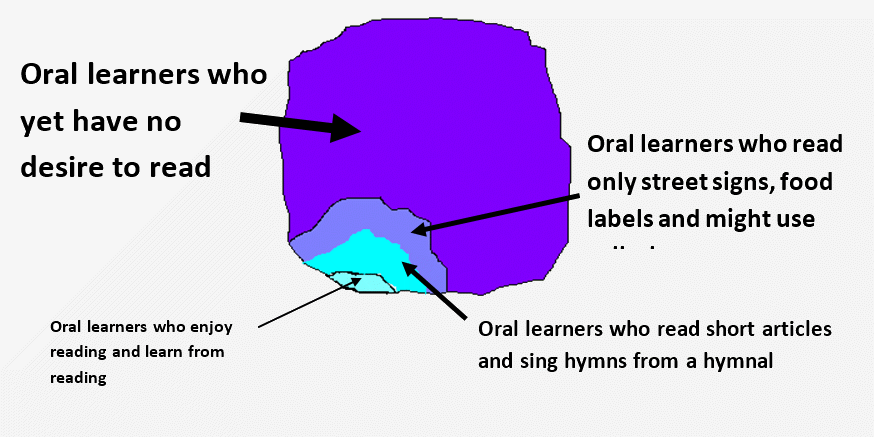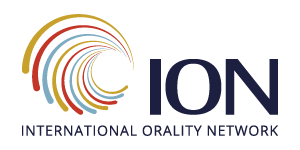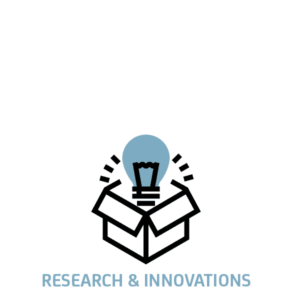The following is a chapter from the book ‘Oralities and Literacies: Implications for Communication and Education‘. A chapter will be posted here each week.
Chapter 10 – The Rationale for Orally Communicating the Scriptures
by Willis Ott
God has given our privileged generation many gifts that no other generation has known in the combination that we have including, but not limited to:
- A widening expertise for exegeting the Scriptures.
- A widening permission for translators that they may communicate the Scriptures meaningfully.
- A widening recognition that the majority of every language group in the world will never respond to the Scriptures through reading.
- A widening access and use of hand-held audio devices all over the world.
- An availability of economically feasible equipment for recording and editing audio files.
- A widening knowledge of how humans communicate and of how individuals convince others of new ideas.
Now in our times, the possibility of humans communicating with other humans by means of recorded speech has flourished. It is now time to begin a radical new epoch—the epoch of oral communication of God’s message. I do not use the word “radical” lightly. We all should recognize that our helping oral learners to respond to God’s invitation will require a radical approach and new thinking for us literates.
Oral communication of God’s message is radical
It is radical because speakers of the language can do the task with guided assistance. An oral translator of the Bible has the task of presenting the Christian world view to an audience that is generally resistant to change. It is sometimes hostile or at best indifferent. Thus, an oral presentation is likely to be the only message that might affect a change of worldview. I suggest that oral translation is accomplished best by native speakers communicating in native oral styles. I am suggesting that they begin with oral translation. Eventually they might print. Oral communication of god’s message is radical because when the mode of communication matches better the mode of learning the people are more likely to accept it as valid.
It is very important to properly translate God’s message, but it is more important that the message be accepted as valid. Every human has his or her personal worldview to which he or she relates in the whole gamut of life-experiences. Every human resists changing that worldview and will change it only when a credible and more advantageous view is offered. By the messengers communicating orally, they are facilitating the message reaching any given people more early than any print oriented method. More importantly, an oral message penetrates more deeply.
All effective communication is between one human to another. In video, commercials are designed with living persons to convince the viewers that they need the product. In audio media, the speaker is a fellow human, one of the listeners’ language group. The sounds of one’s own language imply legitimacy for the message. Legitimacy of the message facilitates the listeners’ decision-making faculties, especially in regard to their worldviews. An audio version of Scripture has two special qualities that make it effective: it is very natural in its style and vocabulary; and the listeners are learning in their natural, accustomed mode of learning. Listening requires minimum mental processing on the part of the audience, whereas reading requires several mental processes.
It is important that communicators recognize that everyone in the world learns by means of what they hear. Not only that, but also most people prefer to learn by listening. Most people are also visual learners.
All people are oral learners

Oral learners who read only street-signs, labels or might use cell-phones
Some people in a language group venture out of their comfort zone to interact with people of other cultures. Some immigrate to cities where they must orient themselves to the cultural patterns of others, such as knowing the street where they live or where they might beg or work. Mostly, they learn to recognize labels on manufactured products by the major color of the labels. Some of them advance economically, even to the point of owning a cell-phone or a television. A much smaller group advance enough to own a cell-phone and thus they learn to press the proper sequence of buttons to be able to talk to people. They understand icons well, but they cannot read full sentences. They never read a newspaper or even a comic book. All those people continue to learn through hearing messages and seeing visuals.
Oral learners who haltingly read the Scriptures and songs in a hymnal
A few will learn to read hesitantly, sounding out the words. Their focus is on the process of recognizing the shapes of the letters. Reading is hard work. Learning is minimal. However, they learn to find the right hymn by the number but they sing the hymns largely from memory, rather than from recognizing the words.
Oral learners who enjoy reading and who learn from reading
A very small percentage might actually know how to read. When we communicate the Scriptures in print media, we must recognize that we are communicating to only a very small minority of the receptor group, although they are usually the powerful among that group. Even in those groups where there is a strong church, the printed Scriptures will be utilized only by a few—the pastors and lay-workers. Yes, it is legitimate that we develop ways to teach people to read, so that the minority increases. We must use every device possible. But it is urgent that we reach beyond the few.
Oral communication is radical also because the listeners are comfortable in their normal mode of learning.
One hundred percent of the world’s population (hearing-impaired persons excepted) learns from what they hear. Within even the most literate societies, perhaps only 5 percent desire to learn through reading. The majority prefer to hear and see. Even those who know how to read will respond more deeply to messages that they hear and see. The key factor for a person accepting of a new concept or idea is the credible source. If we want people to believe the message, we must present it in a mode in which they are comfortable and with voices that the listeners trust.
Oral communication is radical because any communication in the oral media is very different from communication in the print media.
| Oral media | Print media | |||
| The short term and final goal is to communicate God’s message.
The focus is on the audience, how they learn and how they respond to information. The focus is also on facilitating the listeners changing their worldview to the Christian worldview. The method is to communicate the concepts in a way that a living person speaks to another person. This facilitates a learner presenting the message to others, person to person, with minimal special training. The procedure presents learnable chunks of information in an incremental sequence, because we recognize that people learn by increments. |
The short term is to distribute the encrypted message to deeply interested people (less than 10% of any population). The long term is to present a standard of faith that is trustworthy.
The focus is on protecting the message so that it can be trusted as unchangeable, from generation to generation. The method is to present a book that people will honor. The procedure is to print books and distribute them to whoever is interested. Even when we produce audio recordings of a printed text, we expect that the users will listen to the recordings as if they were hearing someone read the text. (However, we are likely to be mistaken if we assume a consistent strong interest in the content.) |
|||
Oral communication is radical also because the translation process is different from the process of drafting texts.
| Accuracy in oral translation | Accuracy in printed translation | |||
| The translator hears an audio recording of a meaningful accurate version in the Language of Wider Communication. In such a version, most of the abstract concepts and ambiguous issues are explicated.
The team carefully minimizes some concepts that are not important to the message or leave them implicit until the recording of the whole documents. They make “native” the foreign names or we communicate them in a general way. Accuracy is first tested in community checks and through a different person back-translating the audio recording. More accuracy is verified by an experienced consultant reviewing the back-translation. |
The print translator is trained in principles of communicating in writing and translating in print.
He or she bases the translation on several printed texts and as many exegetical helps that are usable to him or her. Accuracy is tested in community checks and a through a different person back-translating the text. More accuracy is verified by an experienced consultant reviewing the back-translation and discussing issues with the team. |
|||
This style of training is radical because we facilitate translators in their learning to communicate the oral message instead of training them to create documents.
| Facilitating exploration sessions | Training in workshops | |||
| We suggest that new teams present to their audiences selected passages that focus on a topic. The selections are short, germane to the audience and appropriate for oral learners.
We suggest to the teams that they introduce the passage with a personal comment or recommendation, so that the listeners are able to recognize that the new information is coming from a valid member of their community. We suggest that the teams finish each session with a provocative message that challenges the listeners to learn more or to make a decision about the concepts they have heard. |
Workshops generally focus on the exegesis of a given document of the New or Old Testament.
Workshops facilitate the teams in their attempts to communicate the meaning of the sentences and paragraphs of the document in focus. Most workshops are based on a schedule of lectures. There is generally an expectation that the lectures will enlighten the translators about the whole text of the document in focus. There is an expectation that the teams will complete their translation of the document in focus, and that they will complete it before beginning to translate another document. |
Our facilitation of translators is radical also because it is constructive instead of instructive.
We expect to encourage teams to experiment;
- in finding the ways to record on a hand-held recorder/player,
- in recognizing the techniques of communication through voice modulation and stress,
- in recognizing the differences of effectiveness from using or not using idioms, and
- in talking together about what they are learning.
The facilitator anticipates, as much as possible, the learners’ conceptions about translating and communicating, and attempts to guide the activities toward the desired conceptions, helping the learners to increment their abilities.
Our facilitation of translators must be radical also because we want the translation teams to be able to replicate their facilitation in others.
We expect the team that we facilitate will deepen their own abilities by their facilitating others to learn some of the skills they have learned by guided discovery. Not only do we anticipate the teams facilitating others, we expect that the oral translations that they develop will be readily usable by the people who hear them, not only for personal use but also for talking with others.
Since the oral communication of God’s message is so radical, we ought to use a different set of jargon to talk about the concepts when we train oral translators.
We literates have all been raised in the print-oriented culture and we continue to live in the literate culture. As we facilitate new teams, would it not be well that they learn a descriptive jargon? It would be easier for the teams to communicate the concepts in their languages to their people. (See “Descriptive ways for referring to the way people talk” at https://drive.google.com/file/d/0B3fz3KyACuZrZGhsMEk3ajFNREU/view?usp=sharing .)
If anyone is interested in the companion to this article, “The strategy for communicating orally the Scriptures”, go to: https://drive.google.com/file/d/0B3fz3KyACuZrNHU3Nm5rdEZCblU/view?usp=sharing.
« One – Moses’ Story Connecting for Change: The Multi-Faceted Aspects...»








